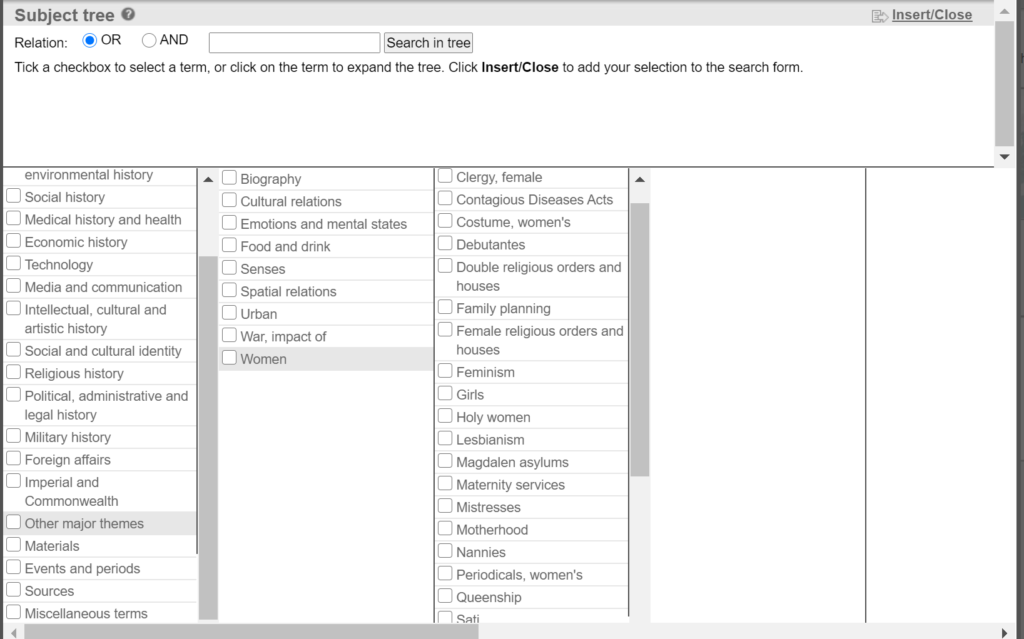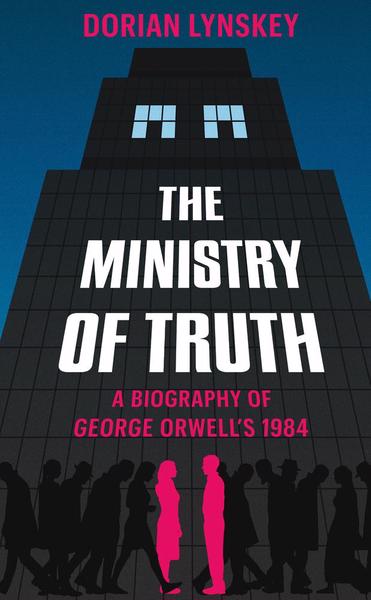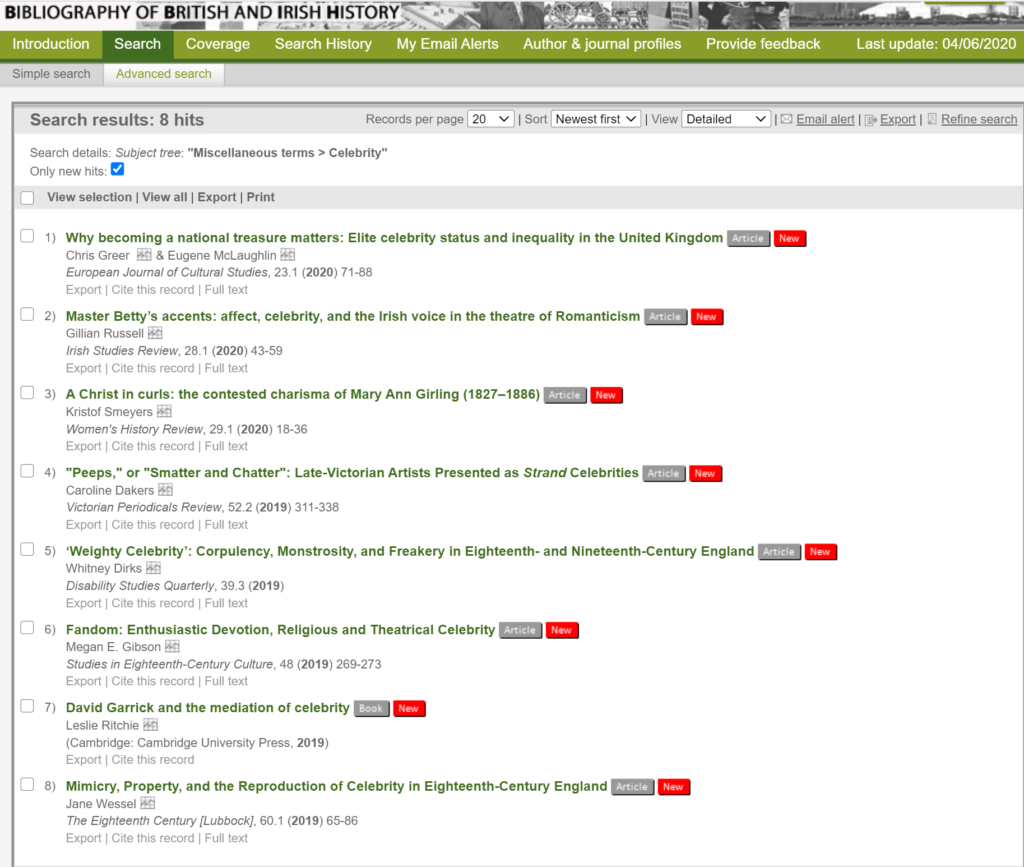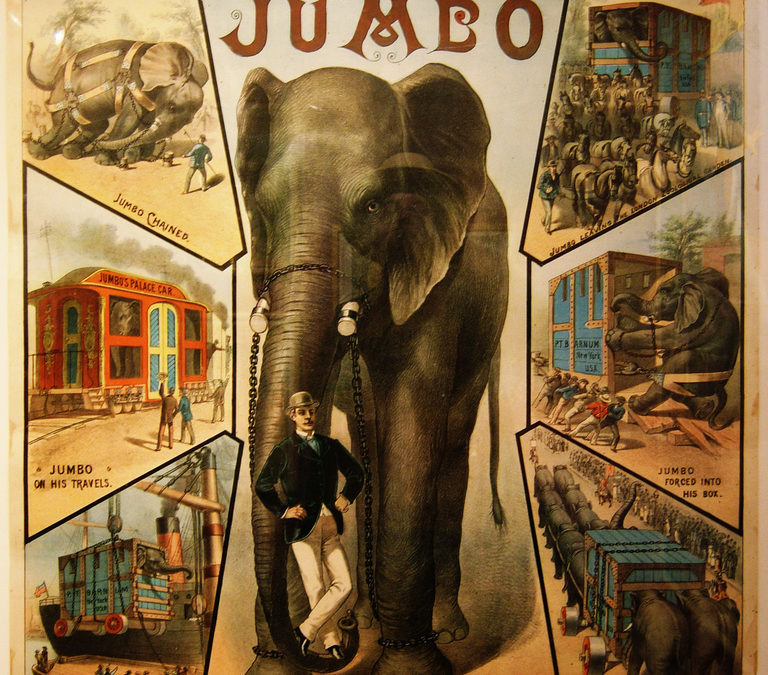The Bibliography of British and Irish History (BBIH) is a record of nearly 620,000 books, articles and essays relating to the British and Irish past, worldwide. The Bibliography is updated three times a year, with the latest update (June 2020) adding records of 4288 new publications — the majority of which cover titles published in 2019-20.
In a previous post we explored the geographical range of the June 2020 update. Here, the BBIH editors explore the range of topics and subjects covered in the new update. We start by surveying the top 10 index terms that have been used in the latest update – giving us a sense of the major themes on which people are currently writing.
We then offer four perspectives on new titles that caught the attention of BBIH editors this time: on the ‘animal turn’ in history, on medieval religious women, on biography, and on new histories of celebrity.
‘Literature’ is by far the most popular subject term from the 4288 new records added to the Bibliography in June 2020. This isn’t perhaps surprising as ‘literature’ in BBIH includes all forms of literature such as medical and religious works, as well as popular literature, poetry, and medieval romances. It also indicates the increasing interdisciplinarity of history and literature studies that we see as we survey recent publishing trends. Examples here include From terror to terrorism in Bleak House: Writing the event, representing the people and Romanticism and the letter.
| Literature | 545 |
| Women | 430 |
| Urban | 284 |
| Gender relations | 257 |
| Biography | 256 |
| Wars, World War I | 217 |
| Wars, World War II | 170 |
| Drama | 148 |
| Archaeological sources and methods | 133 |
| Primary sources: editions and guides | 109 |
ranked by index terms applied when creating records for the Bibliography
Similarly the index term ‘Women’ includes a range of nested terms including queenship, motherhood, women’s costume, female religious houses etc. Both world wars feature in the top ten with World War I in the lead, most likely as a result of ongoing publications to mark the centenary of the 1914-18 war.

***
Alongside this numerical approach, we can also consider the June 2020 update in terms of themes and academic innovation. What topics and approaches catch the eye, and what are some of the emerging trends in recent History publishing? Here are four subjects to emerge from the latest update covering new books, articles and chapters in British and Irish History, published between 2018 and 2020.
The ‘animal turn’ in BBIH, by Roey Sweet
What is the connection between the Book of Job and the sex life of elephants? The answer, as Avi Lifschitz shows, lies in an eighteenth-century dispute over pachyderms’ procreation in which the competing authority of biblical scholarship and natural history were brought to bear. Lifschitz’s article is probably the most eye-catching of the 60 items in the June 2020 update relating to ‘animals’, publications that range from popular attitudes to cranes in medieval Wales to the employment of military and civil defence dogs in the second world war.
It is the horse, however, that receives the most academic attention, reflecting the historical centrality of the equine / human relations to western civilisation: six items come from The horse in premodern European culture but horses feature prominently in another eight items ranging from histories of polo; media representations of the death of Emily Wilding Davison (killed by falling under the race horse Anmer), horse-racing at Newmarket as a site of political intrigue; the fate of Shergar; horses (and mules) in military service; the burial of an Irish cavalry horse; and horses as a means of transportation in the early modern period.

This growing momentum behind the ‘animal turn’ is evident in the number of edited and companion volumes (always a sure sign that a sub-field has been established) that feature in the June update, including five essays from the Routledge Companion to Animal-Human History and essays from Perspectives on the Non-Human in Literature and Culture and Framing Animals as Epidemic Villains. Other titles, such as Murdering animals: writings on theriocide, homicide and nonspeciesist criminology, challenge the distinction between ‘humans’ and ‘animals’ and the underlying ‘specisism’ inherent in such terminology: perhaps the Bibliography’s indexing term ‘animals’ should be replaced by ‘non-human animals’.
***
‘Female religious orders and houses’, by Sara Charles
Given my research interests, one of my most used search terms in the BBIH is ‘Female religious orders and houses’, which currently lists 1085 publications. The graph below gives a distribution of these titles over area and time period (in England).

It’s interesting that this subject term has so many resources relating to other countries, possibly as a result of medieval religious networks, nuns moving to the Continent after the Reformation, and also through their missionary work. As the second graph shows, in England titles relating to the medieval and early modern are dominate, which is perhaps unsurprising in the pre- and immediately post-Reformation world. Using BBIH like this—to get a breakdown of published material—really helps me to visualise patterns in research fields, while asking questions of the results allows me to delve down deeper.
Particular highlights from the June 2020 update include Gender in medieval places, spaces and thresholds, a collective volume of essays which came from the 2017 Gender and Medieval Studies conference. In February 2020 we added a new ‘types of publication’ search to BBIH. This allows me to select titles that are just monographs, just articles, just book chapters and so on. In my field this search reveals previously hidden research such as theses, including ‘The Nunneries of London and its Environs 1100–1400’, by Janet Mary Jones. Further afield, we have examples such as The Brigidine sisters in Ireland, America, Australia and New Zealand, 1807–1922 by Ann Power, and ‘Forgetting Apartheid: History, culture and the body of a nun’ an article by Leslie Bank.
Searching through BBIH results also makes it easy to identify particular trends in publishing, for example, the subject of education with Caroline Bowden’s Convent schooling for English girls in the ‘exile’ period, 1600–1800 and a recent flurry of articles about Nano Nagle, the founder of Sisters of the Presentation of the Blessed Virgin Mary, who was a pioneer of female education in Ireland.
***
‘Biography’, by Philip Carter
Ten per cent of new BBIH records added in June 2020 are indexed with reference to forms of historical life writing (‘biography’, ‘autobiography’, ‘memoir’ etc.) or to the sources (‘letters’, ‘correspondence’, ‘diary’) on which historical biographers draw. Biography as a route to the past is in robust health, and there are few chronologies, subject areas or regions to which life writing won’t take you: from the blind Irish harper Turlough Carolan (1670-1738) to Mary Barkas (1889-1959)—a forgotten pioneer of Antipodean psychoanalysis, to Ghana’s first president Kwame Nkrumah (1909-1972). Like no other genre, biography also reveals the current range and richness of historical research and publishing.
Among the latest additions to BBIH there are, of course, new works on familiar faces, including Austen, Dickens, Wittgenstein and Chaucer, in Marion Turner’s Wolfson Prize shortlisted study of ‘A European life’. In each case, new takes on household names emerge from the major academic presses. But the bulk of BBIH’s new biographical content is the work of much smaller publishers—often with an intensely regional focus, as with the Stories of the Men on the Bo’ness War Memorial (Bo’ness Town Trust Association, 2019) or Ordinary Women in Extraordinary Times: eleven Cork women in the revolutionary years, 1916-1923, from the Shandon History Group. In addition to its use by local historians, biography is also the approach of choice for many historians of the military, sporting life and popular entertainment.

The new BBIH update also reveals a taste for more episodic and perhaps experimental forms of historical biography. Family and group lives remain popular, with no network as popular as Dr Johnson and his circles, not least in Leo Damrosch’s collective biography, The Club: Johnson, Boswell and the Friends who Shaped an Age. Others employ a biographical approach despite the partiality of sources—as in Sarah Watling’s 2019 Noble savages. The Olivier Sisters: four lives in seven fragments—while interest in object biography continues with Dorian Lynskey’s The Ministry of Truth: the biography of George Orwell’s 1984.

Pulling out from ‘traditional’ biography to more person-centred histories leads to some innovative and exciting research, especially in the early modern period. Read across the grain, and set in their wider context, letters, diaries and personal tokens are central to new studies such as Fiona McCall’s ‘Women’s experience of violence and suffering as represented in loyalist accounts of the English Civil War’, Elaine Chalus’s ‘Coping with separation during the Napoleonic Wars (the Fremantle papers, 1800–14)’ and Sally Holloway’s The game of love in Georgian England: Courtship, emotions, and material culture. Here the ego-documents that remain central to traditional biography prompt new histories of emotion, or—in Karen Harvey’s ‘Epochs of embodiment’—fresh perspectives on human physicality shaped less by gender than by relationships and age.
***
‘Celebrity’, by Simon Baker
Many moons ago it was suggested that the IHR hold a conference on celebrity as a historical concept. At that time the idea was dismissed as being a little too fanciful. A little later the journal Celebrity Studies emerged focusing on ‘the critical exploration of celebrity, stardom and fame. It seeks to make sense of celebrity by drawing upon a range of (inter)disciplinary approaches, media forms, historical periods and national contexts.’ In 2016 a conference was held looking at celebrity culture from the eighteenth century to the Victorian period and the International Celebrity Studies conference is now in its fifth year. Indeed, a review of A Short History of Celebrity describes this as ‘a hot academic topic’.
The subject term ‘Celebrity’ was added to BBIH in 2010. But what, historically speaking, is celebrity, fame or stardom?—terms all too often used for Hollywood actors, sports personalities and reality TV stars. Long before film, celebrity was being observed in the acting careers of the eighteenth-century actors David Garrick (see David Garrick and the mediation of celebrity) and Sarah Siddons, as in the recent ‘Sarah Siddons, sensibility and enthusiastic devotion in the British Enlightenment‘.

Well before celebrity magazines like Hello and Heat, the eighteenth century had its own periodicals (now discussed in Magazine miniatures: Portraits of actresses, princesses, and queens in late eighteenth-century periodicals) while the Victorian equivalents are considered in ‘“Peeps,” or “Smatter and chatter”: Late-Victorian artists presented as Strand celebrities‘.
The June 2020 update suggests both that ‘Celebrity’ is now an established historical topic and one that’s developing to offer more nuanced perspectives on the past. Yes, Sarah Siddons still appears as a subject but she’s now set against studies of, for example, the Georgian Methodist preacher George Whitefield in ‘Fandom: Enthusiastic devotion, religious and theatrical celebrity’ For the same period we also have ‘”Weighty celebrity”: corpulency, monstrosity, and freakery in eighteenth- and nineteenth-century England‘, which considers the popular status of Edward Bright and Daniel Lambert. The latter article includes another favourite index term– ‘Body, attitudes to’–but that’s a whole new blog.

***
About the Bibliography of British and Irish History

The Bibliography of British and Irish History (BBIH) is the largest and most comprehensive guide available to what’s been written about British and Irish history, from the early 1900s to 2020.
It’s an essential resource for research and teaching, providing up-to-date information (and links) on nearly 620,000 History books, articles, chapters, edited collections and theses.
New records are added in three annual updates. These records are searchable by a wide range of facets including: title, author, chronology, date and form of publication, historical topic and geographical region.
The Bibliography is a research project of the UK’s Institute of Historical Research and the Royal Historical Society, and is published by Brepols. BBIH is a subscription service and is available remotely via university and research libraries worldwide.
- Roey Sweet is Academic Director of BBIH and Professor of Urban History at Leicester University
- Sara Charles is Assistant Editor of the Bibliography of British and Irish History at the IHR
- Philip Carter is Head of Digital and Publishing at the IHR
- Simon Baker is Editor of BBIH at the IHR

